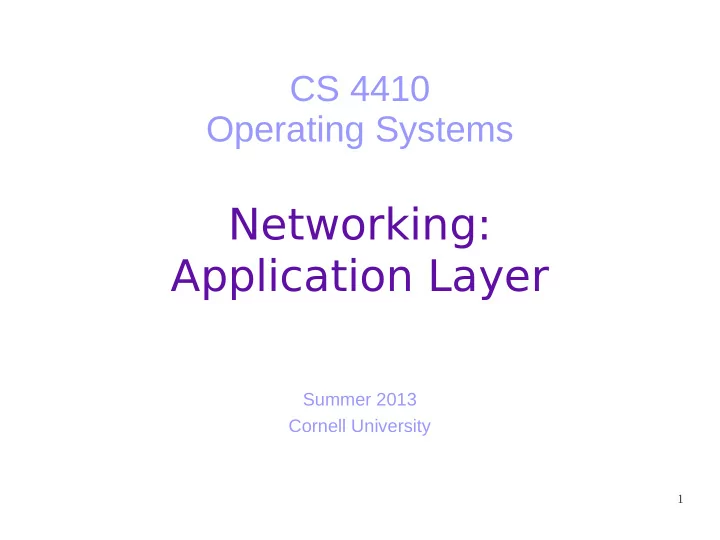

CS 4410 Operating Systems Networking: Application Layer Summer 2013 Cornell University 1
Today ● DNS ● End-to-End Argument 2
DNS When a user wants to communicate with a remote node, is it easier to remember ● 69.63.176.13 or www.facebook.com? Human-friendly names are given to nodes. ● Simultaneously, a translation mechanism should exist between names and IP ● addresses. Packets need IP addresses to be transmitted. ● Will we use arbitrary or well-structured names? Why? ● It affects the efficiency of the translation mechanism. ● Nowadays, we use Domain Names. ● Well-structured strings. ● Multiple labels separated by dots. ● They create a hierarchical Domain Name Space. ● Use: ● 3 Emails, web sites ●
DNS root com uk org edu cornell harvard cs ece mae Hierarchical Domain Space ● Every domain name should belong to this tree. ● When a process wants to send data to www.facebook.com, somebody needs to ● provide the IP translation. Who? 4 Domain Name Service ●
DNS ● Can we have only one server in the network which would provide the translations of all domain names? Why? ● DNS uses multiple DNS resolvers (servers) in the network and the translations are distributed among them. How? ● Each DNS resolver is responsible for a subset of the Domain Name space. 5
DNS Example: ● Suppose we want to access www.cs.cornell.edu. ● First, the DNS resolver in the OS contacts root DNS server and asks if it knows ● the translation of www.cs.cornell.edu. The root does not know the translation, but it knows the DNS server that is ● responsible for .edu addresses. Thus, it forwards the request there. The DNS server for .edu does not know the translation, but it knows the DNS ● server responsible for the cornell.edu addresses. Thus, it forwards the request there. The DNS server for cornell.edu does not know the translation, but it knows the ● DNS server responsible for the cs.cornell.edu addresses. Thus, it forwards the request there. Finally, the DNS server for cs.cornell.edu addresses sends the IP address of the ● wed site www.cs.cornell.edu. Improvement: ● One or more of these DNS servers may have cached the translation from ● previous requests, accelerating the DNS query. 6
End-to-End Argument ● Should the network guarantee packet delivery ? Think about a file transfer program ● Read file from disk, send it, the receiver reads packets and writes them ● to the disk ● If the network guaranteed packet delivery, one might think that the applications would be simpler No need to worry about retransmits ● But still need to check that the file was written to the remote disk intact ● ● A check is necessary if nodes can fail Consequently, applications need to be written to perform their own ● retransmits No need to burden the internals of the network with properties that can, ● and must, be implemented at the periphery 7
End-to-End Argument ● Application-specific properties are best provided by the applications, not the network Guaranteed, or ordered, packet delivery, duplicate suppression, security, ● etc. ● The Internet performs the simplest packet routing and delivery service it can Packets are sent on a best-effort basis ● Higher-level applications do the rest ● 8
Recommend
More recommend